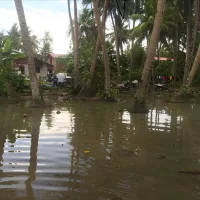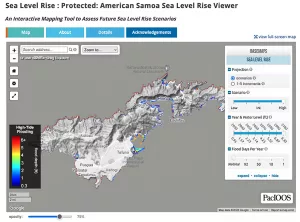
Today, a new interactive tool that will measure local vulnerability to sea level rise will be released. Its called the American Samoa Relative Sea Level Rise Viewer.
The viewer has been under development since August 2020 by the Pacific Islands Ocean Observing System (PacIOOS) at the University of Hawaii School of Ocean and Earth Science and Technology (UH SOEST) and the Department of Oceanography at UH SOEST, in partnership with the Hawaii Sea Grant program and the American Samoa Community College.
Since the earthquake doublet that generated the devastating tsunami in September 2009, American Samoa continues to experience the highest relative rates of sea-level rise in the US due to land subsidence, or sinking of land.
The American Samoa Sea Level Rise Viewer provides users with maps of flooding extent for various combinations of sea-level rise scenarios with the ability to select specific future years, one-foot increments of sea-level rise, and frequency of flooding.
The current version, based on the 2012 digital elevation model, does not include Swains Island but once the 2022 digital elevation model is released, the viewer will be updated with more current elevation and will include Swains Island.
Sea level rise continues to threaten American Samoa’s coastal communities and environment, agriculture, and natural resources. Frequent flooding of coastal areas poses substantial risk to transportation systems, water resources, biological habitats, and ecological systems. The projection and visualization of these impacts are key to local adaption and mitigation planning.
“I had been seeking funding for a sea level rise viewer for our community to empower us to plan for our future,” said Kelley Anderson Tagarino, who serves as the American Samoa Extension Specialist and is based at the American Samoa Community College. 
“Through local, regional, and federal partnerships, funds were secured for the viewer, and I began working with the wonderful team at the UH Sea Level Center to develop it. The UH Sea Level Center secured funds to install four tide gauges in Auasi, Aunu’u, Ofu and Ta’u, to help us understand how our other islands are subsiding. We will also be installing a CORS station to measure elevation in Ofu, in the near future. All these datasets will greatly improve the accuracy of the viewer.”
Funding was also secured for a new Topobathy Light Detection and Ranging (LiDAR) which uses airborne laser-based sensors to measure and record land, water, and submerged land. The data can be used in infrastructure planning and engineering, habitat restoration, and coastal zone management.
Tagarino credited the Pacific Island Climate Adaptation Science Center (PI-CASC) as the funding source for the viewer.
The viewer can be accessed at https://www.pacioos.hawaii.edu/shoreline/slr-amsam/.
There will also be a talk about the American Samoa Relative Sea Level Rise Viewer at the ASCC MPC Auditorium on October 5th from 12:45 to 1:45 PM, which is open to the public.
For more information, contact Kelley Anderson Tagarino at 258-2967 or kelleyat@hawaii.edu.




